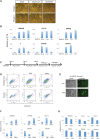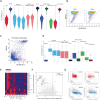Epigenetic resetting of human pluripotency
- PMID: 28765214
- PMCID: PMC5560041
- DOI: 10.1242/dev.146811
Epigenetic resetting of human pluripotency
Erratum in
-
Correction: Epigenetic resetting of human pluripotency (doi:10.1242/dev.146811).Development. 2018 Apr 18;145(8):dev166397. doi: 10.1242/dev.166397. Development. 2018. PMID: 29669738 Free PMC article. No abstract available.
Abstract
Much attention has focussed on the conversion of human pluripotent stem cells (PSCs) to a more naïve developmental status. Here we provide a method for resetting via transient histone deacetylase inhibition. The protocol is effective across multiple PSC lines and can proceed without karyotype change. Reset cells can be expanded without feeders with a doubling time of around 24 h. WNT inhibition stabilises the resetting process. The transcriptome of reset cells diverges markedly from that of primed PSCs and shares features with human inner cell mass (ICM). Reset cells activate expression of primate-specific transposable elements. DNA methylation is globally reduced to a level equivalent to that in the ICM and is non-random, with gain of methylation at specific loci. Methylation imprints are mostly lost, however. Reset cells can be re-primed to undergo tri-lineage differentiation and germline specification. In female reset cells, appearance of biallelic X-linked gene transcription indicates reactivation of the silenced X chromosome. On reconversion to primed status, XIST-induced silencing restores monoallelic gene expression. The facile and robust conversion routine with accompanying data resources will enable widespread utilisation, interrogation, and refinement of candidate naïve cells.
Keywords: Differentiation; Human embryo; Methylome; Pluripotent stem cells; Reprogramming.
© 2017. Published by The Company of Biologists Ltd.
Conflict of interest statement
Competing interestsG.G. and A.Sm. are inventors on a patent filing by the University of Cambridge relating to human naïve pluripotent stem cells. W.R. is a consultant to, and shareholder in, Cambridge Epigenetix.
Figures







References
-
- Amps K., Andrews P. W., Anyfantis G., Armstrong L., Avery S., Baharvand H., Baker J., Baker D., Munoz M. B., Beil S. et al. (2011). Screening ethnically diverse human embryonic stem cells identifies a chromosome 20 minimal amplicon conferring growth advantage. Nat. Biotechnol. 29, 1132-1144. 10.1038/nbt.1974 - DOI - PMC - PubMed
Publication types
MeSH terms
Substances
Grants and funding
- G1100526/MRC_/Medical Research Council/United Kingdom
- 095645/Z/11/Z/WT_/Wellcome Trust/United Kingdom
- BB/K010867/1/BB_/Biotechnology and Biological Sciences Research Council/United Kingdom
- MR/P00072X/1/MRC_/Medical Research Council/United Kingdom
- G1001028/MRC_/Medical Research Council/United Kingdom
LinkOut - more resources
Full Text Sources
Other Literature Sources
Molecular Biology Databases
Research Materials

